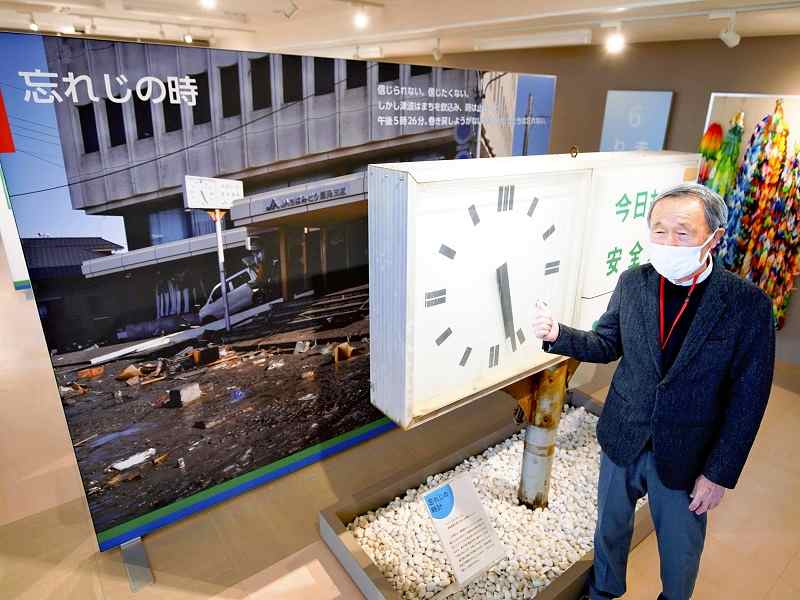
Eiichi Miyamoto stands next to the “wasureji no tokei” (clock of remembrance), which stood about 100 meters from the coast. Its hands are stopped at 5:26.
16:36 JST, March 29, 2022
ASAHI, Chiba — The hands of the clock are stopped at 5:26, when the biggest tsunami wave resulting from the Great East Japan Earthquake struck Asahi, Chiba Prefecture, that afternoon 11 years ago. The timepiece, nicknamed “wasureji no tokei,” meaning “clock of remembrance,” is on display at the Museum of Disaster Prevention in the city.
The exhibition allows visitors to gain a sense of the resilience of the city and remember the lessons learned from the disaster to pass on to future generations.
As tsunami can strike repeatedly and become larger, even after time passes, the largest wave hit Asahi 2 hours and 40 minutes after the massive quake. The first wave hit the coast just an hour after the quake. Fourteen people died and two went missing in Asahi as a result of the Great East Japan Earthquake, the largest number of victims in Chiba Prefecture.
After the first two waves hit, residents hoped the tsunami would subside. However, there was to be a third and largest wave — at 7.6 meters high — still to come. Unfortunately, by this time, some residents had already returned home from evacuation sites.

A series of photo panels show the timeline of when the series of tsunami struck Asahi, Chiba Prefecture.
The text on a photo panel at the museum reads, “As if taking advantage of the moment when people lowered their guard, the ocean rose up with a thunderous sound and swallowed the city.”
In a video showing cars and buildings being swept away, one resident said, “I couldn’t predict this level of [damage].”
Museum storyteller Eiichi Miyamoto, 73, was at home when the third wave hit. He was repeatedly pulled underwater but was finally able to climb onto the roof of a nearby house.
“I regret not evacuating and thinking I’d be OK, even though a tsunami warning had been issued,” he said.
It is a lesson he shares with visitors.
Experts believe the geography of the coast caused waves to concentrate near the city, and as waves receded, they combined with other waves that were heading to shore.
The exhibition also emphasizes the idea of not allowing precedent to dictate actions. Those who experienced tsunami in 1960 caused by an earthquake in Chile were among the slowest to evacuate as not much damage resulted from an earlier wave.

A panel documents the experiences of residents who were living in Asahi, Chiba Prefecture, on March 11, 2011.

Photos and a display show what it was like living in a shelter.
Miyamoto, a native of Asahi, started telling stories at the museum in February 2021. He had felt hesitant about speaking about his survival because some died in the disaster, but now he sees it as a mission to pass down his experience to children.
“Children will likely go through unpredictable things as they become adults, but I just want them to live,” Miyamoto said. “As they go through life, I want them to prioritize trying to live.”
Museum of Disaster Prevention
Opened in 2014, it showcases photos and videos of the restoration and reconstruction after the Great East Japan Earthquake.
Address: 1437 Hagizono, Asahi, Chiba Prefecture (East side of the first floor of the Iioka Shiosai Hotel)
Hours: 9 a.m. to 5 p.m. The museum is closed on Mondays (on Tuesday if Monday is a national holiday) and the day after national holidays.
Admission: Free

"Features" POPULAR ARTICLE
-

Sanrio to Open Museum in Yamanashi Pref. Dedicated to Founder, Exhibits Include Hello Kitty, Other Characters
-

Autumn Foliage Surrounds Visitors to Tokyo’s Showa Kinen Park
-

My Daughter No Longer Speaks to Me, But I Want to See Her and My Grandchild
-

Kumamoto: Public Bath Refurbished as Library Where You Can Chat, Take Photos
-

Frozen Vegetables: Demand Rises for Convenient, Tasty Domestic Produce
JN ACCESS RANKING
-

Tokyo Economic Security Forum to Hold Inaugural Meeting Amid Tense Global Environment
-

Keidanren Chairman Yoshinobu Tsutsui Visits Kashiwazaki-Kariwa Nuclear Power Plant; Inspects New Emergency Safety System
-

Imports of Rare Earths from China Facing Delays, May Be Caused by Deterioration of Japan-China Relations
-

University of Tokyo Professor Discusses Japanese Economic Security in Interview Ahead of Forum
-

Japan Pulls out of Vietnam Nuclear Project, Complicating Hanoi’s Power Plans

























